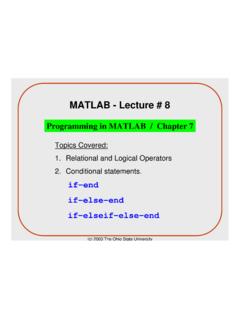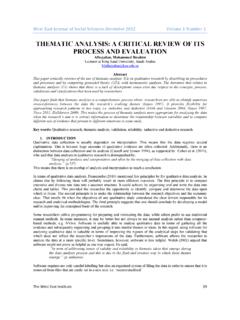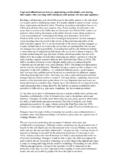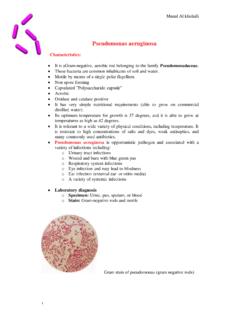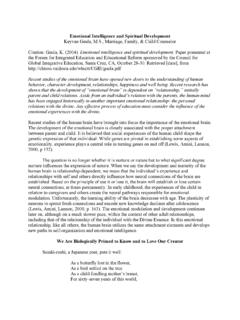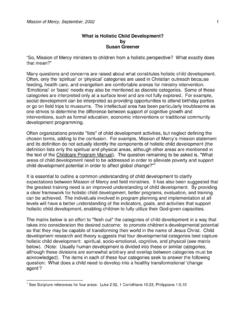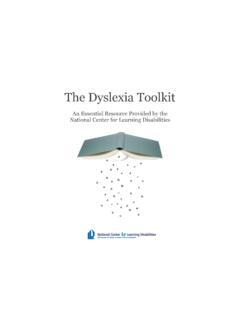Transcription of mymanagementlab - KSU Faculty
1 Mymanagementlabis an online assessment and preparation solution for courses inPrinciples of Management, Human Resources, Strategy, and Organizational Behavior thathelps you actively study and prepare material for class. Chapter-by-chapter activities,including built-in pretests and posttests, focus on what you need to learn and to review inorder to learn A. WhettenBRIGHAM YOUNG UNIVERSITYKim S. CameronUNIVERSITY OF MICHIGANEIGHTH EDITIONP rentice HallBoston Columbus Indianapolis New York San Francisco Upper Saddle RiverAmsterdam Cape Town Dubai London Madrid Milan Munich Paris Montreal TorontoDelhi Mexico City Sao Paulo Sydney Hong Kong Seoul Singapore Taipei TokyoEditorial Director:Sally YaganEditor in Chief:Eric SvendsenAcquisitions Editor:Kim NorbutaEditorial Project Manager:Claudia FernandesDirector of Marketing:Patrice Lumumba JonesMarketing Manager:Nikki Ayana JonesSenior Marketing Assistant:Ian GoldSenior Managing Editor:Judy LealeSenior Production Project Manager:Kelly WarsakSenior Operations Supervisor:Arnold VilaOperations Specialist:Ilene KahnSenior Art Director.
2 Janet SlowikInterior Design:Suzanne Duda and Michael FruhbeisPermissions Project Manager:Shannon BarbeManager, Cover Visual Research & Permissions:Karen SanatarManager Central Design: Jayne ConteCover Art: Getty Images, Design:Suzanne DudaLead Media Project Manager:Denise VaughnFull-Service Project Management:Sharon Anderson/BookMasters, Inc. Composition:Integra Software ServicesPrinter/Binder:Edwards BrothersCover Printer:Coral GraphicsText Font:10/12 Weidemann-BookCredits and acknowledgments borrowed from other sources and reproduced, with permission, in this textbook appear on appropriatepage within 2011, 2007, 2005, 2002, 1998 Pearson Education, Inc., publishing as Prentice Hall, One Lake Street, Upper Saddle River,New Jersey 07458. All rights reserved.
3 Manufactured in the United States of America. This publication is protected by Copyright, andpermission should be obtained from the publisher prior to any prohibited reproduction, storage in a retrieval system, or transmission inany form or by any means, electronic, mechanical, photocopying, recording, or likewise. To obtain permission(s) to use material fromthis work, please submit a written request to Pearson Education, Inc., Permissions Department, One Lake Street, Upper Saddle River,New Jersey 10: 0-13-612100-4 ISBN 13: 978-0-13-612100-8 Library of Congress Cataloging-in-Publication DataWhetten, David A. (David Allred)Developing management skills /David A. Whetten, Kim S. Cameron. 8th bibliographical references and 978-0-13-612100-81.
4 Management -Study and teaching. 2. Management Problems, exercises, etc. I. Cameron,Kim S. II. '173 dc2220090405221098765432 Many of the designations by manufacturers and seller to distinguish their products are claimed as trademarks. Where those designationsappear in this book, and the publisher was aware of a trademark claim, the designations have been printed in initial caps or all xviiIntroduction 1PA RT IPERSONAL SKILLS 441 Developing Self-Awareness 452 Managing Personal Stress 1053 Solving Problems Analytically and Creatively 167 PART IIINTERPERSONAL SKILLS 2324 Building Relationships by Communicating Supportively 2335 Gaining Power and Influence 2796 Motivating Others 3237 Managing Conflict 373 PART IIIGROUP SKILLS 4388 Empowering and Delegating 4399 Building Effective Teams and Teamwork 48910 Leading Positive Change 533 PART IVSPECIFIC COMMUNICATION SKILLS 590 Supplement AMaking Oral and Written Presentations 591 Supplement BConducting Interviews 619 Supplement CConducting Meetings 651 Appendix I
5 Glossary 673 Appendix II References 683 Name Index 705 Subject Index 709 Combined Index 713 BRIEF TABLE OF CONTENTSiiiThis page intentionally left blank Preface xviiINTRODUCTION1 THE CRITICAL ROLE OF MANAGEMENT SKILLS3 The Importance of Competent Managers 6 The Skills of Effective Managers 7 Essential Management Skills 8 What Are Management Skills? 9 Improving Management Skills 12An Approach to Skill Development 13 Leadership and Management 16 Contents of the Book 18 Organization of the Book 19 Practice and Application 21 Diversity and Individual Differences 21 Summary 23 SUPPLEMENTARY MATERIAL24 Diagnostic Survey and Exercises 24 Personal Assessment of Management Skills (PAMS) 24 What Does It Take to Be an Effective Manager?
6 28 SSS Software In-Basket Exercise 30 SCORING KEY AND COMPARISON DATA42 Personal Assessment of Management Skills 42 Scoring Key 42 Comparison Data 42 What Does It Take to Be an Effective Manager? 43 SSS Software In-Basket Exercise 43PA RT IPERSONAL SKILLS 441 DEVELOPING SELF-AWARENESS 45 SKILL ASSESSMENT46 Diagnostic Surveys for Scale Self-Awareness 46 Self-Awareness Assessment 46 Emotional Intelligence Assessment 47 The Defining Issues Test 48 CONTENTSvviCONTENTSC ognitive Style Indicator 52 Locus of Control Scale 52 Tolerance of Ambiguity Scale 54 Core Self-Evaluation Scale (CSES) 56 SKILL LEARNING57 Key Dimensions of Self-Awareness 57 The Enigma of Self-Awareness 58 The Sensitive Line 58 Understanding and Appreciating Individual Differences 60 Important Areas of Self-Awareness 61 Emotional Intelligence 62 Values 65 Ethical Decision Making and Values 72 Cognitive Style 74 Attitudes Toward Change 76 Core Self-Evaluation 79 SKILL ANALYSIS84 Cases Involving Self-Awareness 84 Communist Prison Camp 84 Computerized Exam 85 Decision Dilemmas 86 SKILL PRACTICE89 Exercises for Improving Self-Awareness Through Self-Disclosure 89 Through the Looking Glass 89 Diagnosing Managerial Characteristics 90An Exercise for Identifying Aspects of Personal Culture.
7 A Learning Plan and Autobiography 92 SKILL APPLICATION95 Activities for Developing Self-Awareness 95 Suggested Assignments 95 Application Plan and Evaluation 95 SCORING KEYS AND COMPARISON DATA97 Self-Awareness Assessment 97 Scoring Key 97 Comparison Data 97 Emotional Intelligence Assessment 97 Scoring Key 97 Comparison Data 99 The Defining Issues Test 99 The Escaped Prisoner 99 The Doctor s Dilemma 100 The Newspaper 100 Cognitive Style Indicator101 Scoring and Comparison Data for the Cognitive Style Indicator 101 Scoring Key 101 Comparison Data 101 Locus of Control Scale101 Scoring Key 101 Comparison Data 102 Tolerance of Ambiguity Scale 102 Scoring Key 102 Comparison Data 102 CONTENTSviiCore Self-Evaluation Scale 103 Scoring Key 103 Comparison Data 1032 MANAGING PERSONAL STRESS 105 SKILL ASSESSMENT106 Diagnostic Surveys for Managing Stress 106 Stress Management Assessment 106 Time Management Assessment 107 Type A Personality Inventory 108 Social Readjustment Rating Scale 109 Sources of Personal Stress 111 SKILL LEARNING112 Improving the Management of Stress and Time 112 The Role of Management 113 Major Elements of Stress 113 Reactions to Stress 114 Coping with Stress 115 Managing Stress 117 Stressors 117 Eliminating Stressors 120 Eliminating Time Stressors Through Time Management 121 Eliminating Encounter Stressors Through Collaboration and Emotional Intelligence
8 128 Eliminating Situational Stressors Through Work Redesign 130 Eliminating Anticipatory Stressors Through Prioritizing, Goal Setting, and Small Wins 132 Developing Resiliency 134 Physiological Resiliency 136 Psychological Resiliency 139 Social Resiliency 143 Temporary Stress-Reduction Techniques 144 SKILL ANALYSIS147 Cases Involving Stress Management 147 The Turn of the Tide 147 The Case of the Missing Time 150 SKILL PRACTICE155 Exercises for Long-Term and Short-Run Stress Management 155 The Small-Wins Strategy 155 Life-Balance Analysis 156 Deep Relaxation 158 Monitoring and Managing Time 159 SKILL APPLICATION161 Activities for Managing Stress 161 Suggested Assignments 161 Application Plan and Evaluation 162 SCORING KEYS AND COMPARISON DATA164 Stress Management Assessment 164 Scoring Key 164 Comparison Data 164 Time
9 Management Assessment 164 Scoring Key 164 Comparison Data 165viiiCONTENTSType A Personality Inventory 165 Scoring Key 165 Comparison Data 165 Social Readjustment Rating Scale 166 Comparison Data 166 Source of Personal Stress 1663 SOLVING PROBLEMS ANALYTICALLY AND CREATIVELY 167 SKILL ASSESSMENT168 Diagnostic Surveys for Creative Problem Solving 168 Problem Solving, Creativity, and Innovation 168 How Creative Are You?169 Innovative Attitude Scale 171 Creative Style Assessment 172 SKILL LEARNING174 Problem Solving, Creativity, and Innovation 174 Steps in Analytical Problem Solving 174 Defining the Problem 174 Generating Alternatives 176 Evaluating Alternatives 176 Implementing the Solution 177 Limitations of the Analytical Problem-Solving Model 178 Impediments to Creative Problem Solving 178 Multiple Approaches to Creativity 179 Conceptual Blocks 183 Percy Spencer s Magnetron 185 Spence Silver s Glue 185 The Four Types of Conceptual Blocks 185 Review of Conceptual Blocks 194 Conceptual Blockbusting 194 Stages in Creative Thought 194 Methods for Improving Problem Definition 195 Ways to Generate More Alternatives 199 International Caveats 202 Hints for Applying Problem-Solving Techniques 203 Fostering Creativity
10 In Others 203 Management Principles 204 SKILL ANALYSIS210 Cases Involving Problem Solving 210 The Mann Gulch Disaster 210 Creativity at Apple 212 SKILL PRACTICE214 Exercises for Applying Conceptual Blockbusting 214 Individual Assignment Analytical Problem Solving (10 minutes) 214 Team Assignment Creative Problem Solving (20 minutes) 215 Moving Up in the Rankings 216 Keith Dunn and McGuffey s Restaurant 217 Creative Problem-Solving Practice 220 SKILL APPLICATION222 Activities for Solving Problems Creatively 222 Suggested Assignments 222 Application Plan and Evaluation 222 CONTENTSixSCORING KEYS AND COMPARISON DATA224 Problem Solving, Creativity, and Innovation 224 Scoring Key 224 Comparison Data 224 How Creative Are You?
